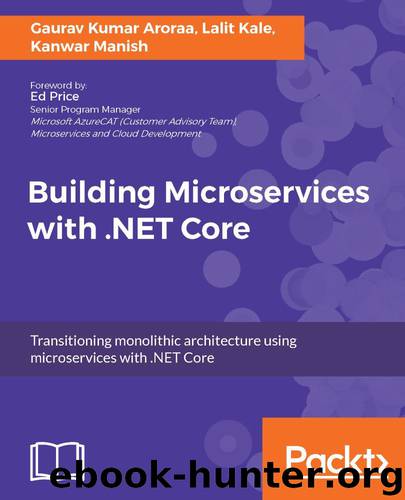Building Microservices with .NET Core by Gaurav Kumar Aroraa & Lalit Kale & Kanwar Manish

Author:Gaurav Kumar Aroraa & Lalit Kale & Kanwar Manish [Aroraa, Gaurav Kumar]
Language: eng
Format: azw3
Publisher: Packt Publishing
Published: 2017-06-14T04:00:00+00:00
Release: A business feature made available to the end user is referred to as the release of a feature. To release a feature or service, the relevant build artifacts should be deployed beforehand. Usually, feature toggle manages the release of a feature. If the feature flag (also called feature toggle) is not switched on in production, it is called a dark release of the specified feature.
Prerequisites for successful microservice deployments
Any architectural style comes with a set of associated patterns and practices to follow. The microservice architectural style is no different. Microservice implementation has more chances of being successful with the adoption of the following practices:
Self-sufficient teams: Amazon, who is a pioneer of SOA and microservice architectures, follows the Two Pizza Teams paradigm. This means usually a microservice team will have no more than 7-10 team members. These team members will have all the necessary skills and roles, for example, development, operations, and business analyst. Such a service team handles the development, operations, and management of a microservice.
CI and CD: CI and CD are prerequisites for implementing microservices. Smaller self-sufficient teams, who can integrate their work frequently, are precursors to the success of microservices. This architecture is not as simple as monolith. However, automation and the ability to push code upgrades regularly enables teams to handle complexity. Tools, such as TFS, Team Foundation Online Services, Teamcity, and Jenkins, are quite popular toolchains in this space.
Infrastructure as code: The idea of representing hardware and infrastructure components, such as networks with code, is new. It helps you make deployment environments, such as integration, testing, and production, look exactly identical. This means developers and test engineers will be able to easily reproduce production defects in lower environments. With tools such as CFEngine, Chef, Puppet, Ansible, and Powershell DSC, you can write your entire infrastructure as code. With this paradigm shift, you can also put your infrastructure under a version control system and ship it as an artifact in deployment.
Utilization of cloud computing: Cloud computing is a big catalyst toward adopting microservices. It is not mandatory as such for microservice deployment, though. Cloud computing comes with near infinite scale, elasticity, and rapid provisioning capability. It is a no brainer that the cloud is a natural ally for microservices. So, knowledge and experience with the Azure cloud will help you adopt microservices.
Download
This site does not store any files on its server. We only index and link to content provided by other sites. Please contact the content providers to delete copyright contents if any and email us, we'll remove relevant links or contents immediately.
The Mikado Method by Ola Ellnestam Daniel Brolund(20590)
Hello! Python by Anthony Briggs(19890)
Secrets of the JavaScript Ninja by John Resig Bear Bibeault(18193)
Dependency Injection in .NET by Mark Seemann(18097)
The Well-Grounded Java Developer by Benjamin J. Evans Martijn Verburg(17566)
OCA Java SE 8 Programmer I Certification Guide by Mala Gupta(17411)
Kotlin in Action by Dmitry Jemerov(17170)
Adobe Camera Raw For Digital Photographers Only by Rob Sheppard(16928)
Algorithms of the Intelligent Web by Haralambos Marmanis;Dmitry Babenko(16223)
Grails in Action by Glen Smith Peter Ledbrook(15381)
Test-Driven iOS Development with Swift 4 by Dominik Hauser(10388)
Becoming a Dynamics 365 Finance and Supply Chain Solution Architect by Brent Dawson(8052)
Microservices with Go by Alexander Shuiskov(7816)
Practical Design Patterns for Java Developers by Miroslav Wengner(7718)
Test Automation Engineering Handbook by Manikandan Sambamurthy(7667)
Angular Projects - Third Edition by Aristeidis Bampakos(7155)
The Art of Crafting User Stories by The Art of Crafting User Stories(6608)
NetSuite for Consultants - Second Edition by Peter Ries(6529)
Demystifying Cryptography with OpenSSL 3.0 by Alexei Khlebnikov(6304)
